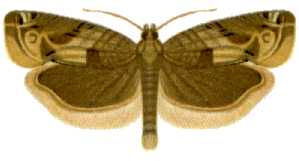Cotton tipworm facts for kids
Quick facts for kids Cotton tipworm |
|
|---|---|
 |
|
 |
|
| figure 66 male, 67 female | |
| Scientific classification | |
| Kingdom: | |
| Phylum: | |
| Class: | |
| Order: | |
| Family: | |
| Genus: |
Crocidosema
|
| Species: |
C. plebejana
|
| Binomial name | |
| Crocidosema plebejana Zeller, 1847
|
|
| Synonyms | |
|
Numerous, see text |
|
The Crocidosema plebejana, also called the cotton tipworm, is a type of tortrix moth. It belongs to the Tortricidae family. You can find this moth in many warm, subtropical and tropical parts of the world. It even lives on many oceanic islands, like those in Polynesia and Saint Helena.
Scientists believe humans likely helped this moth spread to many of these places by accident. It has also been found in cooler areas, such as parts of Europe. For example, it was not seen in the British Isles before the 1900s. This suggests its presence there might also be due to human activity.
This moth is the main example for its genus Crocidosema. Philipp Christoph Zeller created this genus when he first described the moth in 1847. He found it to be very different from any other moth known at that time.
Contents
About the Cotton Tipworm
What it Looks Like
Adult cotton tipworms have a wingspan of about 12 to 16 millimeters. That's about half an inch. Male moths are usually dark brown or black. They have a white spot that looks like an eye and a white patch on their back. Female moths are lighter, often pale brown or tan. They have a dark patch near the base of their wings. This patch does not reach the front edge of the wing.
Where and When it Flies
In places with seasons, like southern England, this moth flies from mid-summer to early autumn. This means you might see it from July to October. In tropical areas, it's not clear if they have several groups of babies born throughout the year. For example, on the Marquesas Islands, they have only been seen between January and April. Adult moths are active in the evening. They are often drawn to lights.
What the Caterpillars Eat
The young moths, called larvae or caterpillars, mostly eat inside the seed pods and shoots of plants. They especially like plants from the Malvaceae family. These include plants like China jute (Abutilon theophrasti), marsh mallow (Althaea officinalis), tree mallow (Lavatera arborea), arrowleaf sida (Sida rhombifolia), and different types of Gossypium (cottons) and Malva (typical mallows).
Caterpillars have also been found on other plants. These include Crataegus hawthorns, Cucurbita pepo pumpkins, and Eucalyptus trees. Sometimes, these caterpillars can become pests for cotton crops. This means they can cause damage to the plants.
See also
 In Spanish: Crocidosema plebejana para niños
In Spanish: Crocidosema plebejana para niños

